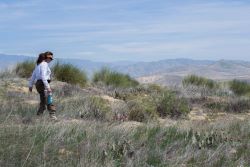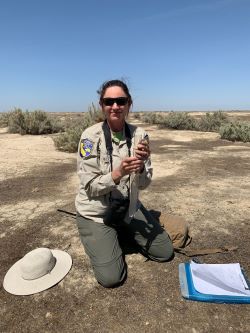Setting up camera trap at Pixley National Wildlife Refuge.

O’Leary working at Sandridge Bakersfield Cactus Preserve.

O’Leary measuring a blunt-nosed leopard lizard at Semitropic Ecological Reserve.
Environmental Scientist Reagen O'Leary monitors wildlife and plant species on CDFW ecological reserves in the Central Valley. She’s part of a small team that helps protect and recover threatened and endangered species and their habitats on about 50,000 acres of CDFW-owned lands. O’Leary studied biology at Fresno State University and held several part-time jobs, including zookeeper at Fresno Chaffee Zoo, veterinary assistant at an animal hospital and scientific aid for CDFW’s Fishing in the City program. She also conducted owl surveys and worked in CDFW’s Lands Unit. Her first full-time position with the state was as an environmental planner for Caltrans. She was hired by CDFW as an environmental scientist in 2011.
When did you know you wanted to be a scientist?
When I was a kid, I enjoyed watching Mutual of Omaha’s Wild Kingdom and Jacques Cousteau documentaries. I was very curious about the natural world and wanted to know how it worked. I was the type of kid who could sit in a field by myself and be entertained by my fascination with the plants and wildlife around me. Growing up, I thought I wanted to be a marine biologist and work with whales and sharks. In my 20s, I worked at a veterinary clinic and realized I liked animals more than people – but not in a clinical setting. That led to my interest in field biology.
What do you enjoy about your job at CDFW?
I love monitoring and taking inventory of the listed species, whether they be plants or wildlife. The wildlife species we typically work with include the blunt-nosed leopard lizard, kangaroo rat species, San Joaquin kit fox, Swainson's hawk and San Joaquin antelope squirrel. I also really enjoy teaching young scientists about the different species and habitats they depend on. I like seeing lightbulbs go off in people’s minds when they learn something new and correlate that knowledge to what they already knew but maybe couldn’t put to words. Young people can be transformed by what they learn, and I enjoy nurturing an appreciation for nature.
What does your job look like on a day-to-day basis?
It depends on the time of year. The field work is varied. For example, we have a long-term lizard monitoring grid that we’ve kicked off for this year that will run in the spring, summer and fall. On hot days we’ll be out in the field early to beat the heat and get back home at a reasonable time. I oversee our annual winter resident bird surveys. I also monitor the status of multiple rare plants on our ecological reserves during the species blooming period. Other duties include setting up camera traps throughout the lands for species detections. We conduct kangaroo rat trapping in the summer, which consists of night work, and during winter we conduct fairy shrimp surveys. Overall, I’ve logged a lot of walking miles in the San Joaquin desert doing all sorts of activities.
As far as day-to-day office work, I coordinate new land acquisitions, write reports, present on our work at conferences, mentor and guide our scientific aids and conduct work funded by grants. I’m the lead staff for coordinating land acquisitions on a Habitat Conservation Plan. I sometimes joke with my colleagues and say, “Who knew we’d need to understand real estate documents to do this job?”
Do you have any recommendations for aspiring scientists?
I would encourage students to be curious about nature and not be scared to ask professionals questions. What I’m discovering with young people is that they sometimes don’t ask enough questions, or they don’t know what questions to ask. Don’t ever think you’re going to learn it all; as a matter of fact, the more you learn, the more you discover what you don’t know. If you are a person with a curious nature, the scientific field is definitely for you. Find folks that like to explore nature and let your curiosity blossom.